Article Information
- Boling GUO, Qiang XU, Zhe YIN. 2016.
- Implicit finite difference method for fractional percolation equation with Dirichlet and fractional boundary conditions
- Appl. Math. Mech. -Engl. Ed., 37(3): 403-416
- http://dx.doi.org/10.1007/s10483-016-2036-6
Article History
- Received Mar. 13, 2015;
- in final form Aug. 10, 2015
2. School of Mathematical Sciences, Shandong Normal University, Jinan 250014, China
Fractional differential equations have attracted considerable attention in recent years due to their applications in physics[1],geology[2, 3],biology[4],chemistry[5],and finance[6]. However,few explicit analytical solutions for fractional differential equations are available. Therefore,numerical methods become the major means to solve fractional differential equations[7, 8, 9, 10, 11, 12, 13, 14, 15, 16, 17, 18].
In recent years,some efficient numerical methods have been considered by many authors. Zheng et al.[19] derived a high order space-time spectral method,employing the Jacobi polynomials for the temporal discretization and the Fourier-like basis functions for the spatial discretization for the time fractional Fokker-Planck initial-boundary value problem. Shen et al.[20] studied the finite difference methods for the non-linear fractional diffusion/wave diffusion equations with a variable order time-fractional derivative operator. Liu et al.[21] developed a novel weighted fractional finite volume method based on the nodal basis functions for the two-sided space fractional diffusion equation,and pointed out that this method could be extended to twodimensional and three-dimensional problems with complex regions. Feng et al.[22] proposed a fractional finite volume method for the two-sided space fractional diffusion equation based on the nodal basis functions,and proved that the derived numerical scheme was unconditional stable and convergent. Liu et al.[23] considered a meshless scheme based on the radial basis functions for a fractal mobile/immobile transport model. Liu et al.[24] developed two meshless schemes based on the point interpolation method for the one-dimensional space fractional diffusion equation. Feng et al.[25] proposed a Crank-Nicolson scheme for the one-dimensional space fractional diffusion equation with a variable coefficient,and proved that the numerical scheme was unconditional stable and convergent with the second-order accuracy. Liu et al.[26] derived a novel alternating direction implicit method for the two-dimensional Riesz space fractional diffusion equation with a non-linear reaction term. Yang et al.[27] established a finite volume scheme with the preconditioned Lanczos method as an attractive and high-efficiency approach for the two-dimensional space fractional reaction-diffusion equations.
The fractional percolation equation (FPE),which is a mathematical model for the seepage flow problems in groundwater and fluid dynamics in porous media[28, 29, 30],is a partial differential equation obtained from the traditional percolation equation[31] by replacing the space integer derivatives by the space fractional derivatives. A three-dimensional FPE is proposed by He[32] as follows:

The space fractional partial derivatives in (1) are defined in the Riemman-Liouville form. Generally,for any μ > 0,the Riemann-Liouville fractional derivative $\frac{{{d}^{\mu }}u(x)}{d+{{x}^{\mu }}}$of the order μ is defined by[33, 34, 35]

In the FPE (1),we denote the rate of the fluid mass flux q = (qx,qy,qz),where

In Refs. [37]-[40],the FPEs are studied with the Dirichlet boundary conditions. As we all know,in seepage flow problems,the Robin boundary condition


Recently,Jia andWang[41] considered the space fractional diffusion equations with fractional derivative boundary conditions,and developed fast implicit finite difference methods for both steady-state and time-dependent problems. To our knowledge,the study on the numerical computation of FPEs with fractional derivative boundary conditions is still limited. This motivates us to examine an implicit finite difference method for the one-dimensional FPE with fractional Robin/Neumann boundary conditions in this paper.
The rest of the paper is organized as follows. In Section 2,we construct an implicit finite difference method,and analyze its consistency. In Section 3,we study the unconditional stability and convergence of the method in two cases. In Section 4,we carry out numerical experiments to verify the accuracy and efficiency of the proposed scheme. Finally,we draw our conclusions in Section 5.
2 Implicit finite difference method and its consistencyIn this section,we discuss the following simplified one-dimensional fractional percolation problem with the left-sided mixed fractional spatial derivative as follows:




Let h = L/N and △t = T/M be the spatial mesh-width and the time step,respectively,where N and M are positive integers. We define a spatial partition by xi = ih (i = 0,1,...,N) and a temporal partition by tm = m△t (m = 0,1,... ,M). Let

To approximate the left-sided mixed fractional spatial derivative,Chen et al.[37] defined the operator �?sub>h,qα,β as follows:










In this section,we discuss the stability and convergence of the numerical method under two special cases,i.e.,a continued seepage flow (β = 1) with a monotone percolation coefficient k(x) and a seepage flow with the fractional Neumann boundary condition (γ= 0).
Let $r = {{{\rm{t}}} \over {{h^{\alpha + \beta }}}}$ be the mesh ratio. Then,we rewrite (14) by exchanging the order of the summation as follows:




Some properties of the alternating fractional binomial coefficients gj(α) and gl(β) in (20) are listed in the following lemma[34].
Lemma 1 Let μ,μ1, and μ2 be positive real numbers,and the integer n �?1. We have
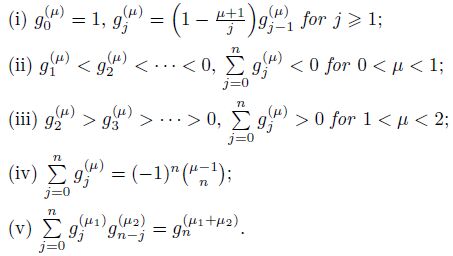
To discuss the stability of the numerical method,we denote by $\tilde{p}_{i}^{m}$ the approximate solution of the difference scheme with the initial condition$\tilde{p}_{i}^{0}$ ,where 1 �?i �?N and 1 �?m �?M,and define







Now,we give the following stability and convergence theorem under the assumption of continuity of the seepage flow (β = 1).
Theorem 1 If β = 1,γ> 0,and k(x) decreases monotonically with respect to x in [0,L],then the implicit finite difference scheme (19) is unconditional stable,and there exists a positive constant C independent of △t and h such that






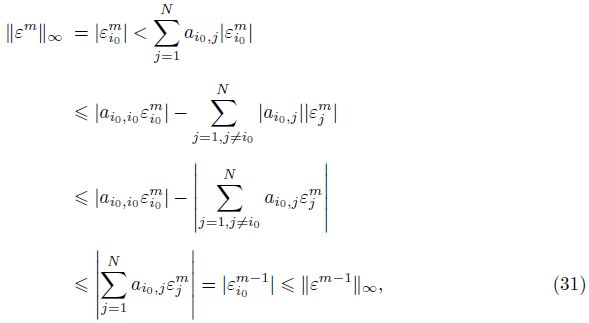

For 1 �?m �? M,if ${{\left\| {{e}^{m}} \right\|}_{\infty }}=\left| e_{N}^{m} \right|\ge \underset{1\le i\le N-1}{\mathop{\max }}\,\left| e_{i}^{m} \right|$,it follows from (24) that
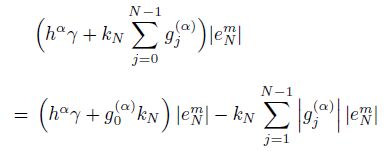
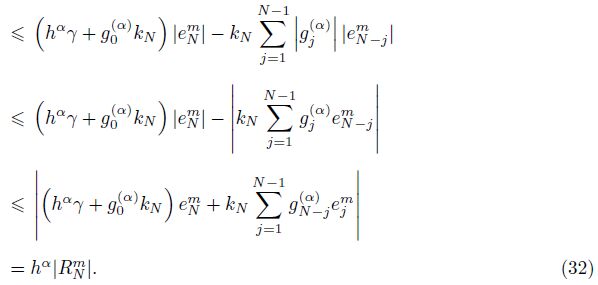




By induction,we can finally obtain

Before proceeding to the case with the fractional Neumann boundary condition ( γ= 0),let us consider a equivalent form of the finite difference scheme (19). We express the coefficient matrix A defined by (20) in a block form as follows:

It is simple to show that the matrix AN�?,N�? has the following decomposition:

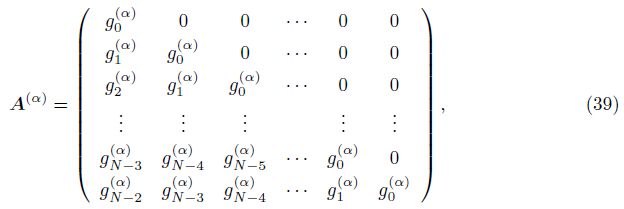
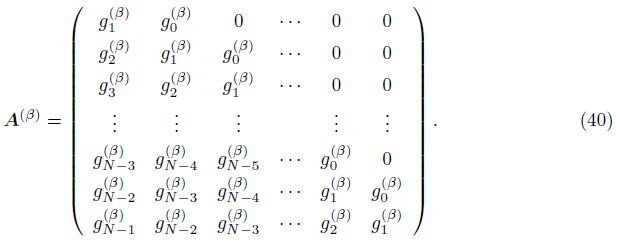







Theorem 2 If 1 < α + β < 2 and γ= 0,then the implicit finite difference scheme (19) is unconditional stable.
Proof Let






Our first goal is to show that the eigenvalues of the matrix A(α)A(β)diag(k) have negative real parts. Denote




Next,by the fact that

Remark 1 Under the assumption of Theorem 2,although a convergence estimate such as (25) is not given,some numerical experiments in Section 4 show that the implicit finite difference scheme defined by (19) is also temporally and spatially first-order accurate.
4 Numerical examplesWe present two numerical examples for solving the initial-boundary value problem of (6)-(8) by the implicit finite difference method given in Section 2. Denote ${{\left\| e_{h}^{M} \right\|}_{\infty }}$ the maximum error of the numerical solution at the time t = T for �?i>t = h. Let ${{G}_{h}}={{\log }_{2}}({{\left\| e_{2h}^{M} \right\|}_{\infty }}/{{\left\| e_{h}^{2M} \right\|}_{\infty }})$reflect the convergence order of the method. All numerical experiments are run in MATLAB on a Thinkpad E420 laptop with the following configuration: Intel(R) Core(TM) i3-2350M CPU 2.30GHZ and 4GB RAM.
Example 1 We solve the initial-boundary problem (6) with the following data. The spatial domain is [0,L] = [0, 1],and the time interval is [0,T] = [0, 1]. The percolation coefficient is




Example 2 In this example,set the spatial domain [0,L] = [0, 1],the time interval [0,T] = [0, 1],and the percolation coefficient



In our numerical experiments,we consider three different α in each case,respectively. Table 1 shows the maximum errors at the time T = 1 for Example 1,where γ = 1 and β = 1.0,it illustrates the stability and the O(�?i>t) + O(h) convergence rate of the implicit finite difference scheme (19) proved in Theorem 1. The error data obtained at the time T = 1 for Example 2,where γ = 0 and β = 0.8,are reported in Table 2,which reflects the stability of the numerical method and supports Theorem 2. In Table 3,the error data at the time T = 1 for Example 2,where γ = 1 and β = 0.8,are given. It is observed from Tables 2-3 that the numerical method is also temporally and spatially first-order accurate for the non-continued seepage flow with the fractional Neumann or Robin boundary condition. This implies that the stability and convergence condition in Theorems 1 and 2 can be weakened.

|

|

|
In this paper,an implicit finite difference method is developed for the one-dimensional FPE with the Dirichlet and fractional boundary conditions. The unconditional stability and convergence of the method are proved for two cases,i.e.,a continued seepage flow with a monotone percolation coefficient and a seepage flow with the fractional Neumann boundary condition. The numerical experiments illustrate the practicability of the numerical scheme. Numerical methods for the two- or three-dimensional FPEs will be considered in our future work.
Acknowledgements
The authors would like to express their sincere thanks to the referees for their valuable comments and suggestions which helped to improve the original paper. The authors are also grateful to Dr.Yongqiang LYU of Shandong Normal University for his helpful suggestions.
| [1] | Sokolov, I. M., Klafter, J., and Blumen, A. Fractional kinetics. Physics Today, 55, 48-54 (2002) |
| [2] | Benson, D. A., Wheatcraft, S. W., and Meerschaert, M. M. Application of a fractional advection- dispersion equation. Water Resources Research, 36, 1403-1412 (2000) |
| [3] | Benson, D. A.,Wheatcraft, S.W., andMeerschaert, M. M. The fractional-order governing equation of Lévy motion. Water Resources Research, 36, 1413-1423 (2000) |
| [4] | Magin, R. L. Fractional Calculus in Bioengineering, Begell House Publishers, Danbury (2006) |
| [5] | Kirchner, J. W., Feng, X., and Neal, C. Fractal stream chemistry and its implications for contam- inant transport in catchments. nature, 403, 524-527 (2000) |
| [6] | Raberto, M., Scalas, E., and Mainardi, F. Waiting-times and returns in high-frequency financial data: an empirical study. Physica A: Statistical Mechanics and Its Applications, 314, 749-755 (2002) |
| [7] | Liu, F., Anh, V., and Turner, I. Numerical solution of the space fractional Fokker-Planck equation. Journal of Computational and Applied Mathematics, 166, 209-219 (2004) |
| [8] | Ervin, V. J. and Roop, J. P. Variational formulation for the stationary fractional advection dis- persion equation. Numerical Methods for Partial Differential Equations, 22, 558-576 (2005) |
| [9] | Ervin, V. J., Heuer, N., and Roop, J. P. Numerical approximation of a time dependent, non-linear, space-fractional diffusion equation. SIAM Journal on Numerical Analysis, 45, 572-591 (2007) |
| [10] | Meerschaert, M. M. and Tadjeran, C. Finite difference approximations for fractional advection- dispersion flow equations. Journal of Computational and Applied Mathematics, 172, 65-77 (2004) |
| [11] | Meerschaert, M. M., Scheffler, H. P., and Tadjeran, C. Finite difference methods for two- dimensional fractional dispersion equation. Journal of Computational Physics, 211, 249-261 (2006) |
| [12] | Li, X. and Xu, C. Existence and uniqueness of the week solution of the space-time fractional diffu- sion equation and a spectral method approximation. Communications in Computational Physics, 8, 1016-1051 (2010) |
| [13] | Lin, Y., Li, X., and Xu, C. Finite dfiference/specrtal approximations for the fractional cable equation. Mathematics of Computation, 80, 1369-1396 (2011) |
| [14] | Chen, C. M., Liu, F., and Burrage, K. Finite difference methods and a Fourier analysis for the fractional reaction-subdiffusion equation. Applied Mathematics and Computation, 198, 754-769 (2008) |
| [15] | Liu, F., Zhuang, P., and Burrage, K. Numerical methods and analysis for a class of fractional advection-dispersion models. Computers and Mathematics with Applications, 64, 2990-3007 (2012) |
| [16] | Shen, S., Liu, F., Anh, V., Turner, I., and Chen, J. A characteristic difference method for the variable-order fractional advection-diffusion equation. Journal of Applied Mathematics and Com- puting, 42, 371-386 (2013) |
| [17] | Liu, F., Meerschaert, M. M., McGough, R. J., Zhuang, P., and Liu, Q. Numerical methods for solving the multi-term time-fractional wave-diffusion equation. Fractional Calculus and Applied Analysis, 16, 9-25 (2013) |
| [18] | Hao, Z. P., Sun, Z. Z., and Cao, W. R. A fourth-order approximation of fractional derivatives with its applications. Journal of Computational Physics, 281, 787-805 (2015) |
| [19] | Zheng, M., Liu, F., Turner, I., and Anh, V. A novel high order space-time spectral method for the time fractional Fokker-Planck equation. SIAM Journal on Scientific Computing, 37, A701-A724 (2015) |
| [20] | Shen, S., Liu, F., Liu, Q., and Anh, V. Numerical simulation of anomalous infiltration in porous media. Numerical Algorithms, 68, 443-454 (2015) |
| [21] | Liu, F., Zhuang, P., Turner, I., Burrage, K., and Anh, V. A new fractional finite volume method for solving the fractional diffusion equation. Applied Mathematical Modelling, 38, 3871-3878 (2014) |
| [22] | Feng, L. B., Zhuang, P., Liu, F., and Turner, I. Stability and convergence of a new finite volume method for a two-sided space-fractional diffusion equation. Applied Mathematics and Computation, 257, 52-65 (2015) |
| [23] | Liu, Q., Liu, F., Turner, I., Anh, V., and Gu, Y. A RBF meshless approach for modeling a fractal mobile/immobile transport model. Applied Mathematics and Computation, 226, 336-347 (2014) |
| [24] | Liu, Q., Liu, F., Gu, Y., Zhuang, P., Chen, J., and Turner, I. A meshless method based on point interpolation method (PIM) for the space fractional diffusion equation. Applied Mathematics and Computation, 256, 930-938 (2015) |
| [25] | Feng, L., Zhuang, P., Liu, F., Turner, I., and Yang, Q. Second-order approximation for the space fractional diffusion equation with variable coefficient. Progress in Fractional Differentiation and Applications, 1, 23-35 (2015) |
| [26] | Liu, F., Chen, S., Turner, I., Burrage, K., and Anh, V. Numerical simulation for two-dimensional Riesz space fractional diffusion equations with a non-linear reaction term. Central European Jour- nal of Physics, 11, 1221-1232 (2013) |
| [27] | Yang, Q., Turner, I., Moroney, T., and Liu, F. A finite volume scheme with preconditioned Lanczos method for two-dimensional space-fractional reaction-diffusion equations. Applied Mathematical Modelling, 38, 3755-3762 (2014) |
| [28] | Petford, N. and Koenders, M. A. Seepage flow and consolidation in a deforming porous medium. Geophysical Research Abstracts, 5, 13329 (2003) |
| [29] | Thusyanthan, N. I. and Madabhushi, S. P. G. Scaling of Seepage Flow Velocity in Centrifuge Mod- els, Technical Report CUED/D-SOILS/TR326, Engineering Department, Cambridge University, Cambridge, 1-13 (2003) |
| [30] | Chou, H., Lee, B., and Chen, C. The transient infiltration process for seepage flow from cracks. Western Pacific Meeting, Advances in Subsurface Flow and Transport: Eastern and Western Ap- proaches III, American Geophysical Union Meetings Department, Beijing (2006) |
| [31] | Bear, J. Dynamics of Fluids in Porous Media, Elsevier, New York, 184-186 (1972) |
| [32] | He, J. H. Approximate analytical solution for seepage flow with fractional derivatives in porous media. Computer Methods in Applied Mechanics and Engineering, 167, 57-68 (1998) |
| [33] | Miller, K. S. and Ross, B. An Introduction to the Fractional Calculus and Fractional Differential Equations, Wiley, New York (1993) |
| [34] | Samko, S. G., Kilbas, A. A., and Marichev, O. I. Fractional Integrals and Derivatives: Theory and Applications, Gordon Breach, Yverdon (1993) |
| [35] | Podlubny, I. Fractional Differential Equations, Academic Press, New York (1999) |
| [36] | Ochoa-Tapia, J. A., Valdes-Parada, F. J., and Alvarez-Ramirez, J. A fractional-order Darcy's law. Physica A: Statistical Mechanics and Its Applications, 374, 1-14 (2007) |
| [37] | Chen, S., Liu, F., and Anh, V. A novel implicit finite difference methods for the one dimensional fractional percolation equation. Numerical Algorithms, 56, 517-535 (2011) |
| [38] | Chen, S., Liu, F., Turner, I., and Anh, V. An implicit numerical method for the two-dimensional fractional percolation equation. Applied Mathematics and Computation, 219, 4322-4331 (2013) |
| [39] | Chen, S., Liu, F., and Burrage, K. Numerical simulation of a new two-dimensional variable-order fractional percolation equation in non-homogeneous porous media. Computers and Mathematics with Applications, 68, 2133-2141 (2014) |
| [40] | Liu, Q., Liu, F., Turner, I., and Anh, V. Numerical simulation for the 3D seepage flow with fractional derivatives in porous media. IMA Journal of Applied Mathematics, 74, 201-229 (2009) |
| [41] | Jia, J. and Wang, H. Fast finite difference methods for space-fractional diffusion equations with fractional derivative boundary conditions. Journal of Computational Physics, 293, 359-369 (2015) |
| [42] | Gray, R. M. Toeplitz and circulant matrices: a review. Communications and Information Theory, 2, 155-239 (2006) |
| [43] | Isaacson, E. and Keller, H. B. Analysis of Numerical Methods, Wiley, New York (1966) |
 2016, Vol. 37
2016, Vol. 37


